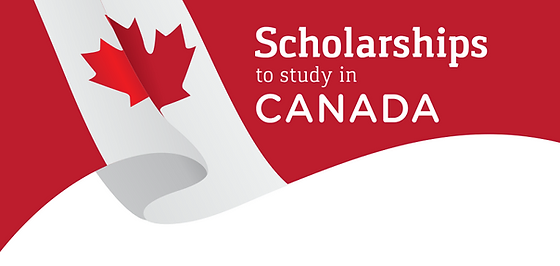Applying for scholarship without a proper guide on how to go about might be difficult, stressful and also a waste of time. But with the right guide it is all easy to do with no much stress or time consuming.
Applying for a scholarship to pursue a Master’s degree in Canadian universities involves a systematic and well-planned process. Here’s a step-by-step guide to help you jump into the scholarship application process effectively:
Research Available Scholarships
Thoroughly researching available scholarships is essential for funding your master’s degree abroad. Start by exploring university websites, government programs, and international organizations offering financial aid to international students. Use scholarship databases like DAAD, Chevening, Fulbright, or Erasmus Mundus, depending on your destination.

Take note of scholarships specific to your field of study or country of origin. Keep track of benefits offered, including tuition, living expenses, travel, and health insurance. Make a spreadsheet to organize deadlines, requirements, and contact details. By identifying scholarships early, you give yourself ample time to gather materials and increase your chances of securing financial support.
- Explore University Websites: Visit the official websites of Canadian universities to identify scholarship opportunities available for Master’s degree programs.
- Government Scholarships: Investigate government-sponsored scholarships, such as the Vanier Canada Graduate Scholarships or the Canadian Commonwealth Scholarship Program.
Step-by-Step On How To Migrate To Canada – Read
Identify Eligibility Criteria
Each scholarship and master’s program has specific eligibility requirements, so it’s crucial to carefully review them before applying. Criteria may include academic qualifications, nationality, language proficiency, work experience, or a specific field of study. Some scholarships require applicants to return to their home country after graduation, while others are open to all international students.
Ensure you meet the minimum GPA or degree classification, and verify whether your academic background aligns with the program. Ignoring eligibility criteria can waste valuable time and effort. If unsure, contact admissions offices or scholarship providers for clarification before starting the application process.
- Review Requirements: Carefully read the eligibility criteria for each scholarship. Ensure that you meet the academic, language proficiency, and any other specific requirements.
Select a Master’s Program
Selecting the right master’s program is key to your academic and career success. Begin by considering your academic interests, long-term career goals, and professional growth opportunities. Research programs that align with your goals, paying attention to course structure, faculty expertise, university rankings, and internship opportunities.
Consider location, tuition fees, and the duration of study. Check if the program offers thesis or non-thesis options and how it supports international students. Read student reviews and speak with alumni if possible. Choosing the right program ensures you gain the knowledge, network, and credentials needed to succeed in your desired field.
- Choose a Program: Identify the Master’s degree program you wish to pursue. Some scholarships may be specific to certain fields of study.
Prepare Application Materials
Preparing strong application materials is vital for gaining admission and securing scholarships. Typical documents include a well-crafted CV, academic transcripts, statement of purpose (SOP), letters of recommendation, and proof of language proficiency. Tailor each SOP to reflect your motivation, academic background, career goals, and why you chose that particular program or university.
Ensure your CV highlights relevant academic, extracurricular, and professional achievements. Choose referees who know your work well and can provide strong endorsements. Proofread all documents for clarity and accuracy. Well-prepared materials demonstrate professionalism and increase your chances of standing out in a competitive applicant pool.
- Academic Transcripts: Gather your academic transcripts, ensuring they are up-to-date and accurately reflect your academic achievements.
- Letters of Recommendation: Request letters of recommendation from professors or professionals who can attest to your academic abilities and potential.
- Statement of Purpose: Craft a compelling statement of purpose that outlines your academic and career goals, why you chose the program, and how the scholarship will contribute to your aspirations.
- Curriculum Vitae (CV): Prepare a detailed CV highlighting your academic achievements, work experience, extracurricular activities, and any relevant skills.
Language Proficiency Tests
Language proficiency tests such as IELTS, TOEFL, or Duolingo English Test are often required for non-native English speakers applying to programs taught in English. These tests assess your reading, writing, listening, and speaking abilities. Some universities may also accept national language tests if you’re applying to non-English programs.
Begin preparing early using practice tests, online courses, and language tutors if necessary. Know the minimum score requirements for each university or scholarship and aim to exceed them. Register for the test well in advance to secure your preferred date. A strong language score can significantly boost your admission and scholarship prospects.
- English/French Proficiency: If you are not a native English or French speaker, take standardized language proficiency tests such as the IELTS or TOEFL for English or the DELF for French, depending on the language of instruction.
Application Submission
Submitting your application correctly and on time is critical. Ensure all required documents are uploaded in the correct format and that every section of the application is complete. Universities may use online portals that require registration, document uploads, and submission fees. Double-check details like deadlines, personal information, and uploaded files before hitting submit.

Submit early if possible to avoid last-minute issues like website traffic or technical errors. After submission, you may receive a confirmation email or tracking number. Keep copies of all submitted materials for your records. Timely and accurate submission reflects your commitment and organizational skills.
- Submit University Application: Apply for admission to the Master’s program at the chosen Canadian university. Follow the university’s admission procedures and deadlines.
- Scholarship Application: Submit the scholarship application separately, following the specific guidelines provided by the scholarship provider.
Read: How to Apply For Jobs as an International Student in Canada – Read
Apply for External Scholarships
External scholarships offer additional funding opportunities beyond those provided by universities. These may be provided by governments, NGOs, or private organizations. Search for scholarships offered in your home country or those targeting international students. Carefully read the requirements and deadlines, which may differ from university timelines.
Prepare a customized application for each, including essays, recommendation letters, and financial documents if needed. Stay organized by keeping a checklist and setting reminders. Applying for multiple scholarships increases your chances of securing financial support, reducing your out-of-pocket expenses and making your study abroad journey more affordable and stress-free.
- Explore External Organizations: Look for scholarships offered by external organizations, NGOs, or foundations that support international students studying in Canada.
- Research Requirements: Carefully review the eligibility criteria and application requirements for external scholarships.
Seek Guidance
Seeking guidance can significantly improve the quality and success of your applications. Reach out to professors, mentors, educational consultants, or alumni who have pursued similar paths. They can offer insights on program selection, application strategies, and scholarship opportunities. University career centers and international offices often provide support for prospective students.
Join forums, attend webinars, and engage in social media groups related to your field. Feedback on your SOP, CV, and interview prep can be invaluable. Expert advice not only strengthens your application but also gives you confidence throughout the process. Don’t hesitate to ask questions and learn from others’ experiences.
- Contact University Officials: If you have questions about the application process or need clarification, reach out to the university’s international admissions office or scholarship coordinators.
- Connect with Alumni: Try to connect with alumni who have previously received scholarships for insights and advice.
Stay Informed about Deadlines
Keeping track of deadlines is essential to avoid missing out on opportunities. Each university, scholarship, and language test may have different timelines. Create a calendar with all important dates, including application deadlines, document submission, interviews, test dates, and visa appointments. Set reminders well in advance to avoid last-minute stress.
Some programs close months before the start date, especially if they involve visa processing or competitive scholarships. Regularly check official websites and your email for updates or changes in deadlines. Being organized and punctual not only ensures you meet all requirements but also demonstrates reliability to admissions committees.
- University and Scholarship Deadlines: Keep track of application deadlines for both the Master’s program and any scholarships you are applying for. Late applications are often not considered.
Prepare for Interviews (if required)
Some programs and scholarships require interviews as part of the selection process. Preparation is key to making a good impression. Research common questions, such as your academic background, motivation, goals, and reasons for choosing the program. Practice with mock interviews, ideally with mentors or peers who can provide constructive feedback.
Focus on clear, confident communication and professional demeanor. Understand the program’s structure and how it aligns with your aspirations. Be prepared to discuss your CV, SOP, and relevant experiences. Dress appropriately and ensure a quiet, distraction-free environment if it’s an online interview. A strong interview can be a decisive factor in your selection.
- Interview Preparation: Some scholarships may require an interview. Prepare for potential interviews by practicing common questions related to your academic and career goals.
Monitor Application Status
After submitting applications, regularly monitor their status through university portals or email notifications. Some institutions update applicants on incomplete documents, interview invitations, or admission decisions. Stay proactive by checking for messages from admissions offices and responding promptly if additional information is requested.
Save login credentials and application IDs securely. If your status remains unclear beyond expected timelines, politely follow up to inquire. Keeping track helps you stay informed, plan ahead, and address any issues before they affect your admission or scholarship outcome. Monitoring your applications ensures that you remain engaged and responsive throughout the process.
- Regularly Check Email: Stay attentive to your email for any communication from the university or scholarship provider. Respond promptly to any requests for additional information.
Plan for Arrival
Once admitted, planning for your arrival is the final step toward beginning your studies abroad. Start by securing your student visa and arranging accommodation. Book flights early for better prices and confirm your travel itinerary. Learn about the host country’s culture, weather, transportation, and healthcare system.

Prepare financial arrangements such as opening a bank account or carrying appropriate currency. Ensure you meet health and vaccination requirements. Pack essential documents and items, considering airline luggage restrictions. Connect with current students or university support services to ease your transition. Proper planning ensures a smooth, confident start to your academic journey.
- Visa and Accommodation: Once accepted, start planning for your arrival. Apply for a study permit, arrange accommodation, and ensure you fulfill all requirements for international students in Canada.
Read: Step-By-Step To Securing Admission Into Canada Schools
Applying for scholarships in Canada involves several key steps, starting with researching available scholarships and identifying eligibility criteria. Carefully select a master’s program that aligns with your goals, and prepare strong application materials, including your CV, statement of purpose, and language proficiency test scores. Submit your application before deadlines and apply for external scholarships for additional funding. Seek guidance from mentors, stay updated on timelines, and prepare for interviews if required. Monitor your application status regularly and plan thoroughly for your arrival in Canada. Following these steps will boost your chances of success in securing scholarships and admission.
APPLY NOW
Important Notice
Staff of JobsGist will never contact you or ask you to contact them for any deal, assistance, or payment. Anyone claiming to represent us in such a manner is not affiliated with us and should be considered a scammer.
Disclaimer: This article is for informational purposes only. We are not visa agents and do not offer any form of assistance beyond announcing verified job vacancies.
